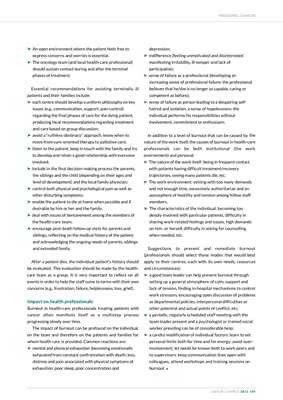
‰ An open environment where the patient feels free to
express concerns and worries is essential.
‰ The oncology team (and local health-care professional)
should sustain contact during and after the terminal
phases of treatment.
Essential recommendations for assisting terminally ill
patients and their families include:
‰ each centre should develop a uniform philosophy on key
issues (e.g., communication, support, pain control)
regarding the final phases of care for the dying patient,
producing local recommendations regarding treatment
and care based on group discussion;
‰ avoid a "ruthless obstinacy" approach; know when to
move from cure-oriented therapy to palliative care;
‰ listen to the patient, keep in touch with the family and try
to develop and retain a good relationship with everyone
involved;
‰ include in the final decision-making process the parents,
the siblings and the child (depending on their ages and
level of development) and the local family physician;
‰ control both physical and psychological pain as well as
other disturbing symptoms;
‰ enable the patient to die at home when possible and if
desirable by him or her and the family;
‰ deal with issues of bereavement among the members of
the health-care team;
‰ encourage post death follow-up visits for parents and
siblings, reflecting on the medical history of the patient
and acknowledging the ongoing needs of parents, siblings
and extended family.
After a patient dies, the individual patient's history should
be evaluated. This evaluation should be made by the healthcare
team as a group. It is very important to reflect on all
events in order to help the staff come to terms with their own
concerns (e.g., frustration, failure, helplessness, loss, grief).
Impact on health professionals
Burnout in health-care professionals treating patients with
cancer often manifests itself as a multistep process
progressing slowly over time.
The impact of burnout can be profound on the individual,
on the team and therefore on the patients and families for
whom health care is provided. Common reactions are:
‰ mental and physical exhaustion (becoming emotionally
exhausted from constant confrontation with death, loss,
distress and pain associated with physical symptoms of
exhaustion, poor sleep, poor concentration and
depression;
‰ indifference (feeling unmotivated and disinterested
manifesting irritability, ill-temper and lack of
participation;
‰ sense of failure as a professional (developing an
increasing sense of professional failure: the professional
believes that he/she is no longer as capable, caring or
competent as before);
‰ sense of failure as person leading to a despairing selfhatred
and isolation, a sense of hopelessness: the
individual performs his responsibilities without
involvement, commitment or enthusiasm.
In addition to a level of burnout that can be caused by the
nature of the work itself, the causes of burnout in health-care
professionals can be both institutional (the work
environment) and personal.
‰ The nature of the work itself: being in frequent contact
with patients having difficult treatment/recovery
trajectories, seeing many patients die, etc.
‰ The work environment: setting with too many demands
and not enough time, excessively authoritarian and an
atmosphere of hostility and tension among fellow staff
members.
‰ The characteristics of the individual: becoming too
deeply involved with particular patients, difficulty in
sharing work-related feelings and issues, high demands
on him- or herself, difficulty in asking for counselling
when needed, etc.
Suggestions to prevent and remediate burnout
(professionals should select those modes that would best
apply to their centres, each with its own needs, resources
and circumstances):
‰ a good team leader can help prevent burnout through
setting up a general atmosphere of calm, support and
lack of tension, finding in-hospital mechanisms to control
work stressors, encouraging open discussion of problems
as departmental policies, interpersonal difficulties or
other potential and actual points of conflict, etc;
‰ a periodic, regularly scheduled staff meeting with the
team leader present and a psychologist or trained social
worker presiding can be of considerable help;
‰ a careful modification of individual factors: learn to set
personal limits both for time and for energy; avoid overinvolvement;
let needs be known both to work peers and
to supervisors; keep communication lines open with
colleagues, attend workshops and training sessions on
burnout. l
PAEDIATRIC CANCER
CANCER CONTROL 2015 109